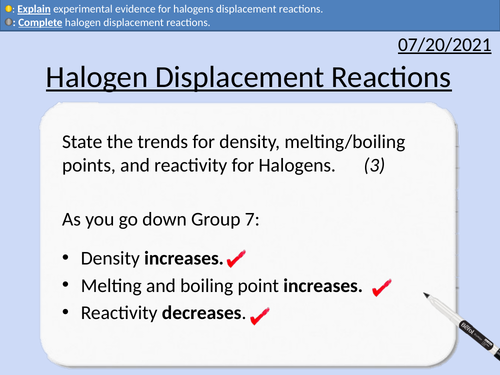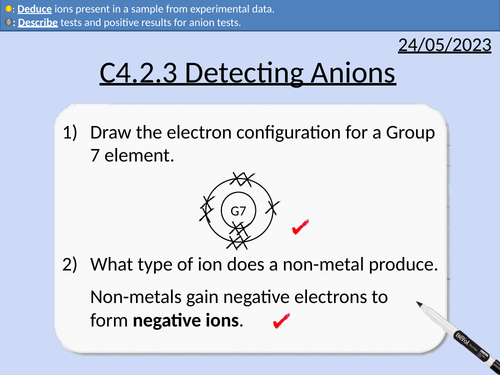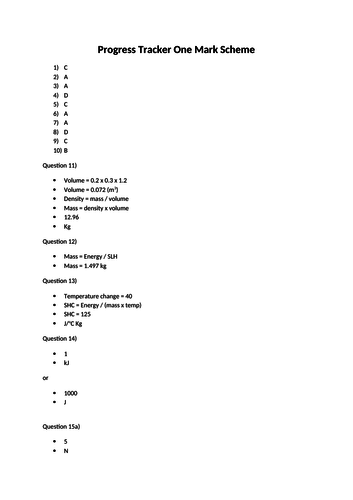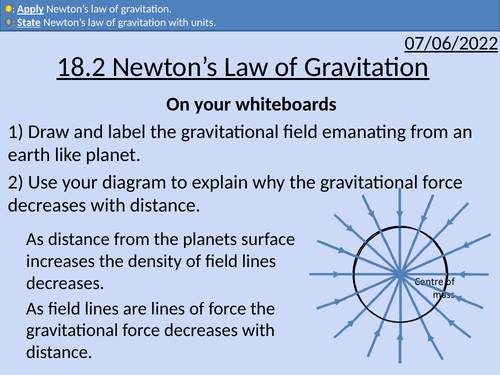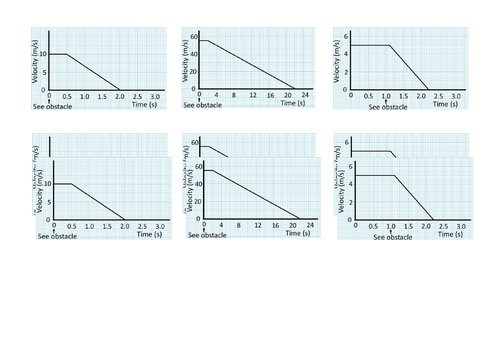499Uploads
171k+Views
72k+Downloads
All resources

GCSE Chemistry: Halogen Displacement Reactions
This PowerPoint presentation with worked examples and student questions covers:
• Definition of halides displacement reactions
• Definition of displacement reactions
• Identifying displaced products
• Completing displacement reactions
• Explaining experimental evidence for displacement reactions.

GCSE Chemistry: Detecting Anions
This PowerPoint presentation with worked examples and student questions covers:
Definitions for anions, cations, anodes, cathodes.
Tests for carbonate ions
Tests for sulfate ions
Tests for halide ions

GCSE Physics: Resistance of a wire practical activity
This presentations covers the OCR Gateway Physics 9-1 P3.2.3 Resistance practical activity with the lenght of conductor and changing resistance.
Combining resistors in series
Ohm’s law
Rearranging equations
Measuring current
Measuring potential difference
Calculating resistance
Plotting the length of a conductor (wire) vs resistance of the conductor.
Interpreting data and stating relationships from data and graphs.

GCSE Physics: The Speed of Sound
This presentation covers OCR Gateway Physics 9-1 P5.1.2a the speed of sound and wave velocity. Includes student activities and full worked answers.
The speed equation
Measuring distance and time
Simple experiment for the speed of sound
Improving experiments
Echoes
Speed of sound experiment with microphones and oscilloscope.

GCSE Physics: Electromagnetic Reflection
This presentation covers OCR Gateway Physics 9-1 P5.3.1a Electromagnetic Reflection. Includes student activities and full worked answers.
Law of reflection
Labeling and measuring angles of incidence and reflection
Practical activity instructions - fully animated.
Reflection, absorption, and refraction is affected by wavelength of electromagnetic wave.

GCSE Physics: Electromagnetic Refraction
This presentation covers OCR Gateway Physics 9-1 P5.3.2a Electromagnetic Reflection.
Includes student activities and full worked answers.
Refraction the change of velocity - speed and direction
Magnitude of refraction depending on wavelength
Magnitude of refraction depending on optical density
Refraction practical activity instructions
Wave speed, wavelength, and frequency relationship in refraction
Bundle

GCSE OCR Physics P5.3 Wave Interactions
Resources for P5.2 GCSE OCR Physics Gateway 9-1 Triple and Combined (Higher and Foundation) is covered in this material.
Each lesson includes student activities and full worked answers.
Law of reflection
Labeling and measuring angles of incidence and reflection
Practical activity instructions - fully animated.
Reflection, absorption, and refraction is affected by wavelength of electromagnetic wave.
Refraction the change of velocity - speed and direction
Magnitude of refraction depending on wavelength
Magnitude of refraction depending on optical density
Refraction practical activity instructions
Wave speed, wavelength, and frequency relationship in refraction
Convex and Concaves lenses
Eyes and corrective lenses
Refraction and wavelength
Focal points for lenses
Determining the type of images produced through a lens
Names of colours for the visible spectrum
Coloured filters
Coloured objects acting as a coloured filters
White light and refracting prism
Refraction and wavelength
Specular reflection
Diffuse scattering
Scattering - Why the sky is blue and milk is white.

OCR AS Physics: Diodes
OCR AS Physics A: Diodes is a part of the Module 4: Electrons, Waves, and Photons. PowerPoint with worked examples and homework.
Polarity of diodes
Conventional current and diodes
Plotting I-V curves for diodes
Describing I-V curves for diodes

GCSE Physics: Atomic Model 2
This presentation covers OCR Gateway Physics 9-1 P1.1.2
Scientific Models
Dalton’s model
Rutherford’s model
Bohr’s model

GCSE OCR Physics P1 Test
35 mark assessment with mark scheme for P1 from OCR Gateway Physics 9-1.
Includes:
10 multiple choice questions
Density
Specific Latent Heat
Specific Heat Capacity
Pressure
Development of the atomic model
Unit conversion
Included physics equations
PIN cover sheet

Scientist of the week reward system
A simple scientist of the week reward system display is included which highlights women and PoC in STEM jobs.

OCR A level Physics: Solids, Liquids and Gases
OCR A level Physics: Solids, Liquids and Gases is a part of the Module 5: Newtonian World and Astrophysics. The PowerPoint presentation includes worked examples, solutions and a homework.

OCR A Level Physics: Newton's Law of Gravitation
OCR A Level Physics:Newton’s Law of Gravitation presentation, homework and answers.

OCR A level Physics: Specific Heat Capacity
OCR A level Physics: Specific Heat Capacity is a part of the Module 5: Newtonian World and Astrophysics. The PowerPoint presentation includes worked examples, solutions and a homework.

GCSE Physics: Gravitational Energy
This presentation covers OCR Gateway Physics 9-1 P7.1.5 Gravitational Energy
Gravitational fields
Rearranging Gravitational Energy Equation
Exam question with worked solutions
Practice questions with worked solutions
Analysing graphs and gradients.

GCSE Physics: Braking and Stopping Distances
This presentation covers OCR Gateway Physics 9-1 P8.1.3 Braking and Stopping Distances. All presentations come with student activities and worked solutions.
Factors affecting braking distance
Total stopping distances
Calculating area of a velocity-time graph for displacement (distance traveled).
Rearranging equations
MOT testing
(Final velocity)2 – (Initial velocity)2 = 2 x Acceleration x Distance
v2 – u2 = 2 a s

GCSE Physics: Sound, Boundaries and Ultrasound
This presentation covers OCR Gateway Physics 9-1 P5.1.3 Sound Properties and Uses. Includes student activities and full worked answers.
Ray diagrams
Absorption, reflection and transmission
Sonar
Ultrasound
Rearranging equation
Refraction
Relationship between wave speed and wavelength
Data analysis
Bundle

GCSE OCR Physics: P2.3 Forces in action
All resources for P2.3 GCSE OCR Physics Gateway 9-1.Triple and comined (Higher and Foundation) is covered in this material.
Includes:
• Stretching springs
• Stretching materials and storing energy
• Gravitational Fields and Potential Energy
• Turning Forces
• Simple Machines
• Hydraulics

GCSE Physics: Electrical Current Practical Activity
This presentation covers OCR Gateway Physics 9-1 P3.1.2 Electrical Current
Electron flow and conventional current
Measuring current with ammeters
Series and parallel circuits
Comparing current at junctions

